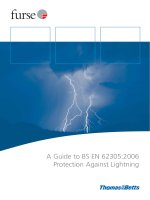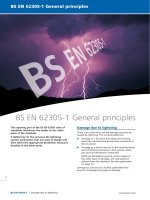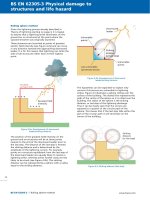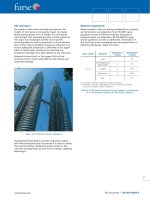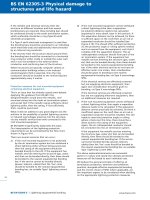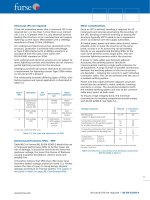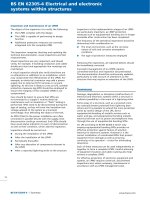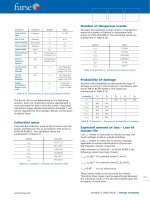Bsi bs en 00828 2013
Bạn đang xem bản rút gọn của tài liệu. Xem và tải ngay bản đầy đủ của tài liệu tại đây (995.09 KB, 16 trang )
BS EN 828:2013
BSI Standards Publication
Adhesives - Wettability Determination by
measurement of contact
angle and surface free
energy of solid surface
BS EN 828:2013
BRITISH STANDARD
National foreword
This British Standard is the UK implementation of EN 828:2013. It
supersedes BS EN 828:1998 which is withdrawn.
The UK participation in its preparation was entrusted to Technical
Committee PRI/52, Adhesives.
A list of organizations represented on this committee can be
obtained on request to its secretary.
This publication does not purport to include all the necessary
provisions of a contract. Users are responsible for its correct
application.
© The British Standards Institution 2013.
Published by BSI Standards Limited 2013
ISBN 978 0 580 72245 5
ICS 83.180
Compliance with a British Standard cannot confer immunity from
legal obligations.
This British Standard was published under the authority of the
Standards Policy and Strategy Committee on 31 January 2013.
Amendments issued since publication
Date
Text affected
BS EN 828:2013
EN 828
EUROPEAN STANDARD
NORME EUROPÉENNE
EUROPÄISCHE NORM
January 2013
ICS 83.180
Supersedes EN 828:1997
English Version
Adhesives - Wettability - Determination by measurement of
contact angle and surface free energy of solid surface
Adhésifs - Mouillabilité - Détermination par mesurage de
l'angle de contact et de l'énergie superficielle libre de la
surface solide
Klebstoffe - Benetzbarkeit - Bestimmung durch Messung
des Kontaktwinkels und der freien Oberflächenenergie
fester Oberflächen
This European Standard was approved by CEN on 24 November 2012.
CEN members are bound to comply with the CEN/CENELEC Internal Regulations which stipulate the conditions for giving this European
Standard the status of a national standard without any alteration. Up-to-date lists and bibliographical references concerning such national
standards may be obtained on application to the CEN-CENELEC Management Centre or to any CEN member.
This European Standard exists in three official versions (English, French, German). A version in any other language made by translation
under the responsibility of a CEN member into its own language and notified to the CEN-CENELEC Management Centre has the same
status as the official versions.
CEN members are the national standards bodies of Austria, Belgium, Bulgaria, Croatia, Cyprus, Czech Republic, Denmark, Estonia,
Finland, Former Yugoslav Republic of Macedonia, France, Germany, Greece, Hungary, Iceland, Ireland, Italy, Latvia, Lithuania,
Luxembourg, Malta, Netherlands, Norway, Poland, Portugal, Romania, Slovakia, Slovenia, Spain, Sweden, Switzerland, Turkey and United
Kingdom.
EUROPEAN COMMITTEE FOR STANDARDIZATION
COMITÉ EUROPÉEN DE NORMALISATION
EUROPÄISCHES KOMITEE FÜR NORMUNG
Management Centre: Avenue Marnix 17, B-1000 Brussels
© 2013 CEN
All rights of exploitation in any form and by any means reserved
worldwide for CEN national Members.
Ref. No. EN 828:2013: E
BS EN 828:2013
EN 828:2013 (E)
Contents
Page
Foreword .......................................................................................................................................................3
1
Scope ................................................................................................................................................4
2
Normative references .......................................................................................................................4
3
Terms and definitions ......................................................................................................................4
4
Principle............................................................................................................................................6
5
Test equipment.................................................................................................................................6
6
Measuring conditions ......................................................................................................................7
7
Procedure .........................................................................................................................................8
8
Expression of results .......................................................................................................................9
9
Test report ........................................................................................................................................9
Bibliography................................................................................................................................................ 11
2
BS EN 828:2013
EN 828:2013 (E)
Foreword
This document (EN 828:2013) has been prepared by Technical Committee CEN/TC 193 “Adhesives”, the
secretariat of which is held by AENOR.
This European Standard shall be given the status of a national standard, either by publication of an identical
text or by endorsement, at the latest by July 2013, and conflicting national standards shall be withdrawn at the
latest by July 2013.
Attention is drawn to the possibility that some of the elements of this document may be the subject of patent
rights. CEN [and/or CENELEC] shall not be held responsible for identifying any or all such patent rights.
This document supersedes EN 828:1997.
Safety Statement
People applying this document, the user shall be familiar with normal laboratory practice. This standard does
not purport to address all the safety problems, if any, associated with its use. It is the responsibility of the user
to establish safety and health practices and to ensure their compliance with the provisions of any regulatory
conditions.
Environmental Statement
It is understood that some of the material permitted in this standard may have a negative environmental
impact. As technological advantages lead to acceptable alternatives for these materials, they will be
eliminated from this standard as far as possible.
At the end of the test, the user of the standard should take care to carry out appropriate disposal of waste,
according to local regulations.
According to the CEN/CENELEC Internal Regulations, the national standards organisations of the following
countries are bound to implement this European Standard: Austria, Belgium, Bulgaria, Croatia, Cyprus, Czech
Republic, Denmark, Estonia, Finland, Former Yugoslav Republic of Macedonia, France, Germany, Greece,
Hungary, Iceland, Ireland, Italy, Latvia, Lithuania, Luxembourg, Malta, Netherlands, Norway, Poland, Portugal,
Romania, Slovakia, Slovenia, Spain, Sweden, Switzerland, Turkey and the United Kingdom.
3
BS EN 828:2013
EN 828:2013 (E)
1
Scope
This European Standard specifies a method for the determination of the surface free energy of a solid surface
by measuring the contact angle of a liquid wetting the solid surface. It allows the prediction of the ability of a
particular adhesive to wet a particular adherend. It can be used to characterise surfaces intended for pretreatment, coating or bonding.
NOTE 1
In order to determine the surface free energy, the method of measuring the static contact angle is used in
combination with a statistical interpretation.
NOTE 2
2
The measurement results are influenced by mechanical surface roughness and chemical homogeneity.
Normative references
The following documents, in whole or in part, are normatively referenced in this document and are
indispensable for its application. For dated references, only the edition cited applies. For undated references,
the latest edition of the referenced document (including any amendments) applies.
EN 923:2005+A1:2008, Adhesives — Terms and definitions
3
Terms and definitions
For the purposes of this document, the terms and definitions given in EN 923:2005+A1:2008 and the following
apply.
3.1
triple point
point where the solid, the liquid and the gas phases coincide with each other
Note 1 to entry: The triple point can be identified in the silhouette of a liquid drop situated on a test piece, at the
intersection of the drop's contour line with the test piece surface.
3.2
baseline
in the case of plane test pieces, a straight line going through the two triple points
3.3
contact angle
θ
angle to the baseline, formed by a tangent to the drop contour going through one of the triple points (see
Figure 1)
4
BS EN 828:2013
EN 828:2013 (E)
Key
1
2
solid body surface
liquid drop
σL surface tension (= surface energy) of the liquid in equilibrium with the gas phase
σS surface free energy of the solid body surface
γSL interfacial energy of the solid body surface in contact with the liquid
θ
contact angle
Figure 1 — Wettability
3.4
wettability
a liquid coming into contact with a solid surface exhibits a typical drop shape. The characteristic of the drop is
the angle formed by the tangent to the contour at the triple point (wetting point) (Figure 1). A contact
angle = 0º indicates a surface that is completely wetted
3.5
contour analysis
image analysis procedure consisting in capturing the silhouette of a liquid drop on a surface by optical
methods and calculating the contour profile of that silhouette
3.6
surface free energy of a solid
σS
energy measure (expressed in mN/m) which characterises the wettability of a solid material by a liquid that is
based on the adsorption theory. The forces present in the state of equilibrium are described by Young's
formula:
σS = γSL + σL ⋅ cos θ
(1)
The Young-Dupré formula defines the work of adhesion obtained during wetting:
Wad = σL + σL ⋅ cos θ = σL ⋅ (1 + cos θ)
(2)
The position of the thermodynamic equilibrium resulting in the formation of the static contact angle depends
on both the pressure and the temperature conditions. When carrying out the measurement, standard
conditions should be maintained.
Since the interfacial energy and the surface energy are based on interactive forces between atoms or
molecules, it is necessary to take polarity into consideration when assessing the wettability.
Examples for polar interactions are as follows:
dipole-dipole interactions;
hydrogen bridge bonds;
acid-base interactions.
5
BS EN 828:2013
EN 828:2013 (E)
The non-polar (disperse) interactions are commonly described as London interactions.
In accordance with [1] and [2], the interfacial energy γSL between a solid body (S for "solid") and a liquid (L for
"liquid") is the sum of the surface tensions of the two phases (σS + σL), reduced by the disperse and the polar
interactions at the phase border. These interactions are described as the doubled sum of the geometric mean
values of the disperse ( σ SD ⋅ σ LD ) and the polar ( σ SP ⋅ σ LP ) tension components of the individual phases:
γSL = σS + σL – 2 ( σ SD ⋅ σ LD + σ sP ⋅ σ LP )
(3)
Substitution γSL from the Young's formula (1) and rearrangement of formula (3) to the general form of a
straight line
y = mx + b
(4)
leads to the following formula:
(1 + cosθ ) ⋅ σ L
σP
y
x
L
= σ SP
+ σ SD
D
D
σL
2 σL
m
b
(5)
The square of the slope is the polar proportion of the solid body surface energy σ SP , the square of the ordinate
intercept b is the disperse proportion σ SD . The sum of the two proportions is the total surface free energy of the
solid body σS.
4
Principle
Ten drops each of at least three and up to eight known, different liquids are dosed onto a plane test piece
surface. For each drop, the left and the right contact angles are measured. From the averaged contact angles
of each liquid combined with its surface tension and its polar and disperse proportions, the surface free energy
of the solid body is calculated, subdivided into the polar and the disperse proportions.
Preferably, the liquids used should exhibit different polar and disperse proportions of the interfacial tension.
Recommended liquids and their characteristic interfacial tensions are listed in Table 1.
The drop volumes suitable for the measurement depend on the type of the liquid and should be adjusted such
that the negative influence of gravity on the contact angle is kept to a minimum.
5
5.1
Test equipment
Solid surface to be assessed, substrate with pre-treated or untreated surface.
5.2 Contact-angle measuring system, any contact-angle measuring device, preferably systems
comprising digital image acquisition and image analysis to comply with the current state of the art. Figure 2
gives an example of a schematic representation of a contact-angle measuring system.
6
BS EN 828:2013
EN 828:2013 (E)
Table 1 — Recommended test liquids
Surface tension
Disperse proportion
Polar proportion
Literature
mN/m
mN/m
mN/m
(Author)
Water
72,80
21,80
51,00
See [3]
Diiodomethane
50,80
50,80
0,00
See [3]
Ethylene glycol
47,70
30,90
16,80
See [3]
Glycerol
63,40
37,00
26,40
See [3]
Hexadecane
27,60
27,60
0,00
See [3]
44,60
44,60
0,00
See [3]
Benzyl alcohol
38,90
29,00
9,90
See [4]
Decalin
30,60
30,60
0,00
See [3]
Designation of the
test liquid
α-Bromine
naphthalene
Key
1
2
3
4
5
lighting
sample carrier
dosage
optical system
screen
Figure 2 — Contact-angle measuring system
5.3
Reagents, at least three and up to eight of the test liquids recommended in Table 1.
WARNING — These reagents are chemicals — carefully follow the safety advice on the labels and in
the safety data sheets.
5.4 Micropipette (or suitable syringes for micro-dosing) which can be fastened above the sample carrier or
the surface to be tested, respectively, by means of an appropriate holder.
6
Measuring conditions
Constant measuring conditions in accordance with the thermodynamic state function (temperature and
pressure) shall be maintained.
7
BS EN 828:2013
EN 828:2013 (E)
7
Procedure
7.1
The contact-angle measuring device shall be adjusted horizontally by means of the level.
7.2 The contact-angle measuring device, the lighting and the image acquisition and analysis system are
switched on. The image display is adjusted to be sufficient with regard to brightness and contrast (the
manufacturer's information should be taken into consideration).
The light source of the contact-angle measuring device shall be calibrated to obtain optimum contrast and
grey scale value in the image of a drop and of a surface.
The dosing needle is moved to the upper edge of the image and the zoom of the contact-angle measuring
device is set in a way that the contour width of the located drop covers two thirds of the width of the image.
Afterwards the drop image shall be focussed.
7.3 The dosing system is filled with one of the selected liquids. It shall be ensured that any contaminations
during filling are avoided.
7.4 A plane sample of the surface to be measured is placed on the sample carrier. The sample carrier shall
be adjusted such that the sample surface is located in the lower half of the image and in a horizontal position.
7.5 The dosing needle is positioned approximately 1 mm above the sample surface. The drop shall be
dosed such that its volume is between 2 µl and 6 µl, depending on the liquid selected. Recommended drop
volumes are given in Table 2, depending on the liquid selected.
Table 2 — Recommended drop volumes
Liquid
Drop volume
µl
Water
2–6
Diiodomethane
2–3
Ethylene glycol
2–6
Glycerol
2–6
Hexadecane
2–6
α-Bromine naphthalene
2–6
Benzyl alcohol
2–6
Decalin
2–6
7.6 One drop of the test liquid is dosed onto the surface. In doing so, the drop volumes given in Table 2 and
the dosing rate of 100 µl/min shall not be exceeded.
7.7 The baseline shall be adjusted such that it intersects the triple points of the drop. In order to facilitate
locating the triple points, a top-view angle of maximally 2° may be set. The maximum deviation of the baseline
from the horizontal (slope) shall not exceed 0,1.
7.8 The measurement shall be started immediately (max. 15 s) after the completion of dosing. Over the
contact period, no reaction and no mutual material conversion between the test liquid and the surface to be
measured shall take place. As an example, it is recommended to carry out one measurement every second
over a period of 20 s.
8
BS EN 828:2013
EN 828:2013 (E)
7.9 Depending on how the individual liquid drops behave on different solid body surfaces, different
algorithms shall be applied for the accurate determination of the contact angle (e.g. equation of a circle for
contact angles < 20°, a quadratic equation for contact angles between 20° and 120°, polynomial equation for
contact angles > 120°).
7.10 Repeat sub-clauses 7.3 to 7.9 for a total ten drops of each liquid. In order to get sufficient information
concerning the homogeneity of a sample, the measurements shall be carried out at different areas of the
sample. Uncertain records which may have been caused by dust, contamination etc., are not included in the
evaluation. The contact angle results from the mean value of the measurement values for each liquid.
7.11 The sub- clauses 7.3 to 7.9 shall be repeated for each test liquid selected. The liquids shall be selected
so that a maximum variation of the polar and the disperse proportions is represented.
NOTE
A higher number of test liquids increase the informative value of the results.
Used liquids shall not be filled back into the respective sample jar or storage bottle. They shall be discarded
and properly disposed off after the end of the measurements.
8
Expression of results
For the evaluation of the surface free energy, the term
(1 + cosθ ) ⋅ σ L
2 σ LD
is plotted against the term.
σ LP
σ LD
where
θ
are the measured and averaged contact angles for the individual liquids;
σL
are the total surface tensions of the liquids;
σ LP and σ LD
are the polar and the disperse proportions of the total surface tensions.
Subsequently, the slope m and the ordinate intercept b of the straight line are determined by linear regression.
The square of the slope is the polar proportion of the solid body surface energy σ SP , the square of the
ordinate intercept b is the disperse proportion σ SD . The sum of the two proportions is the total surface energy
of the solid body σS.
9
Test report
The test report shall contain the following information:
a)
a reference to this European Standard, i.e. EN 828;
b)
complete description of the solid surface;
c)
the test liquids used and their surface tensions as well as their polar and disperse proportions of the
surface tension;
d)
drop volumes and dosing rate used;
e)
temperature conditions applied for measuring;
9
BS EN 828:2013
EN 828:2013 (E)
f)
method (algorithm) of determining the contact angle of the drop;
g)
number of drops per liquid;
h)
average contact angle for the selected liquids and the polar proportion of the solid body surface
energy σ SP , the disperse proportion σ SD and the total surface free energy of the solid body σS derived
from that angle;
i)
standard deviation of contact-angle measurement for each liquid;
j)
statistical error of the surface free energy as well as of the polar and the disperse proportions of the
surface free energy of the solid body, taking into consideration the statistical errors of the individual
measurements;
k)
all deviations from the described method and their potential influence on the results;
l)
date when the test was performed.
10
BS EN 828:2013
EN 828:2013 (E)
Bibliography
[1]
W. K. Owens, R. C. Wendt, Estimation of the surface free energy of polymers, J. Appl. Polymer
Science, 13, 1969, 1741–1747
[2]
D. H. Kaelble, Dispersion-Polar Surface Tension properties of organic solids, J. Adhesion, 2, April
1970, 66–81
[3]
G. Ström, M. Frederiksson, P. Stenius, J. Coll. Interf. Sci. 119 (2), 352–361
[4]
Rabel, Farbe und Lack, 77 (10), 997–1005 (1971)
11
This page deliberately left blank
This page deliberately left blank
NO COPYING WITHOUT BSI PERMISSION EXCEPT AS PERMITTED BY COPYRIGHT LAW
British Standards Institution (BSI)
BSI is the national body responsible for preparing British Standards and other
standards-related publications, information and services.
BSI is incorporated by Royal Charter. British Standards and other standardization
products are published by BSI Standards Limited.
About us
Revisions
We bring together business, industry, government, consumers, innovators
and others to shape their combined experience and expertise into standards
-based solutions.
Our British Standards and other publications are updated by amendment or revision.
The knowledge embodied in our standards has been carefully assembled in
a dependable format and refined through our open consultation process.
Organizations of all sizes and across all sectors choose standards to help
them achieve their goals.
Information on standards
We can provide you with the knowledge that your organization needs
to succeed. Find out more about British Standards by visiting our website at
bsigroup.com/standards or contacting our Customer Services team or
Knowledge Centre.
Buying standards
You can buy and download PDF versions of BSI publications, including British
and adopted European and international standards, through our website at
bsigroup.com/shop, where hard copies can also be purchased.
If you need international and foreign standards from other Standards Development
Organizations, hard copies can be ordered from our Customer Services team.
Subscriptions
Our range of subscription services are designed to make using standards
easier for you. For further information on our subscription products go to
bsigroup.com/subscriptions.
With British Standards Online (BSOL) you’ll have instant access to over 55,000
British and adopted European and international standards from your desktop.
It’s available 24/7 and is refreshed daily so you’ll always be up to date.
You can keep in touch with standards developments and receive substantial
discounts on the purchase price of standards, both in single copy and subscription
format, by becoming a BSI Subscribing Member.
PLUS is an updating service exclusive to BSI Subscribing Members. You will
automatically receive the latest hard copy of your standards when they’re
revised or replaced.
To find out more about becoming a BSI Subscribing Member and the benefits
of membership, please visit bsigroup.com/shop.
With a Multi-User Network Licence (MUNL) you are able to host standards
publications on your intranet. Licences can cover as few or as many users as you
wish. With updates supplied as soon as they’re available, you can be sure your
documentation is current. For further information, email
BSI Group Headquarters
389 Chiswick High Road London W4 4AL UK
We continually improve the quality of our products and services to benefit your
business. If you find an inaccuracy or ambiguity within a British Standard or other
BSI publication please inform the Knowledge Centre.
Copyright
All the data, software and documentation set out in all British Standards and
other BSI publications are the property of and copyrighted by BSI, or some person
or entity that owns copyright in the information used (such as the international
standardization bodies) and has formally licensed such information to BSI for
commercial publication and use. Except as permitted under the Copyright, Designs
and Patents Act 1988 no extract may be reproduced, stored in a retrieval system
or transmitted in any form or by any means – electronic, photocopying, recording
or otherwise – without prior written permission from BSI. Details and advice can
be obtained from the Copyright & Licensing Department.
Useful Contacts:
Customer Services
Tel: +44 845 086 9001
Email (orders):
Email (enquiries):
Subscriptions
Tel: +44 845 086 9001
Email:
Knowledge Centre
Tel: +44 20 8996 7004
Email:
Copyright & Licensing
Tel: +44 20 8996 7070
Email:

